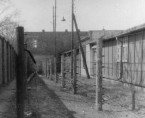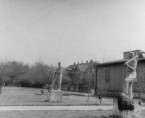Jawischowitz
A sub-camp located in the village of Jawiszowice (in German: Jawischowitz). The prisoners held there worked in two shafts of the Brzeszcze coal mine located in the localities of Jawiszowice and Brzeszcze. The camp began functioning in mid-August 1942 when 150 French Jews arrived under an agreement between the WVHA and the Reichswerke Hermann Göring, which owned the mine. This was the first time in the history of the German concentration camps that prisoners were employed below ground. In terms of the number of prisoners, Jawischowitz was one of the largest Auschwitz sub-camps. In June 1944, it held 2,500 prisoners, mostly Jews from Poland, France, Germany, the Netherlands, Italy, and Hungary. There were also Poles, Russians, and Germans in the sub-camp.
At the turn of 1943/1944 there were at least 70 SS men in the garrison. The first director was SS-Unterscharführer Wilhelm Kowol, who was succeeded by SS-Hauptscharführer Josef Remmele. The sub-camp was surrounded by electrified barbed-wire fencing. It consisted of more than ten barracks, most of them wooden. Prisoners lived in seven of them and the rest contained a kitchen, hospital, storage space, workshops, washrooms, and toilets. Despite the expansion of the sub-camp, the prisoner rooms were overcrowded in 1944, with more than 200 men in rooms designed for 54.
The prisoners had two changes of clothes at their disposal—work clothes that they took off at the showers after their shift, and the clothes they wore in the sub-camp. Thanks to their everyday showers and changing of clothes, dictated by the nature of work in the mine, they did not suffer from the lice that were a serious problem for prisoners in other parts of the Auschwitz complex. The work in the mine exhausted them, however. They loaded carts with coal, transported them, made repairs, and did construction work in a three-shift system with quotas that they were sometimes unable to fulfill because they were hungry, weak, or did not know how to do the job. On such occasions, their shift was extended until the norms were met. Prisoners also worked above ground at various sorts of construction jobs. In the second half of 1944, several score underage Jewish prisoners were assigned to sort the coal.
SS doctors held selection every few weeks, after which the prisoners classified as unfit for labor were taken to Auschwitz. Most of them were murdered in the gas chambers there. According to partially extant records from October 1942 to December 1944, at least 1,800 sick prisoners were removed from Jawischowitz.
In January 1945, about 1,900 prisoners were evacuated on foot to Wodzisław Śląski. Several score sick and exhausted prisoners were left behind; Soviet soldiers liberated the majority of them on January 29. After liberation they were taken into the care of the local branch of the Polish Red Cross.


